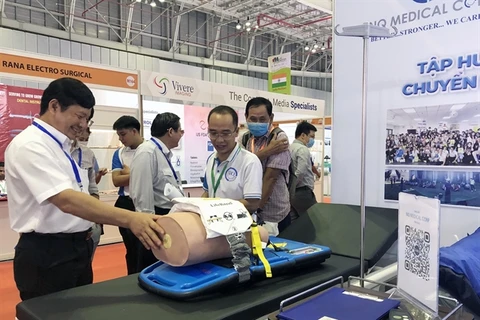 A man has his blood pressure checked by a medical worker under the Healthy Family programme in Vietnam. (Photo courtesy of Novartis Vietnam)
A man has his blood pressure checked by a medical worker under the Healthy Family programme in Vietnam. (Photo courtesy of Novartis Vietnam) Swiss drug company Novartis launched its Healthy Family programme in the country in 2012 along with the Vietnam Cardiovascular Foundation and local health departments.
It currently operates in 19 provinces in the northern, central and Mekong Delta regions.
It seeks to educate rural people in prevention of various diseases, promote better hygiene and nutrition and expand access to health services, including diagnosis and treatment.
Through health camps, doctors travel to rural areas to provide screening, diagnosis, treatment, and preventive care for hypertension and diabetes for people aged over 40 in 37 provinces and cities.
On average, each year it provides medical services to 200,000 people.
Of the number, 15-20% are diagnosed with high blood pressure and 7-8% with high blood sugar levels.
The patients receive initial treatment and are referred to the nearest qualified provider for follow-up care.
Access to primary healthcare remains limited in remote areas in the country such as Bac Giang, Yen Bai, Lang Son, and Dak Lak provinces where health stations are far and few between.
Besides, due to the shortage of medical staff and doctors, many people miss the opportunity to be screened early during the “golden time” for treatment.
Speaking at the recent 10th anniversary of the programme in Long An province, Huynh Huu Dung, director of the Long An Centre for Disease Control, said the programme was playing a big role in helping improve people’s health.
Carolyne Hall, director of Novartis’s Global Health Access Solution Center of Excellence, said the programme met the affordability criterion in rural areas especially by providing care close to home and minimising travel costs.
Non-communicable diseases (NCDs) now account for more than 70% of total incidences and deaths globally.
If NCDs are diagnosed early and effectively managed, people with chronic conditions can live a healthy and productive life. But many remain undiagnosed.
In Vietnam, the mortality due to NCDs is four times higher than that due to infectious diseases, and cardiovascular disease is the leading cause of death (33%).
Hypertension and diabetes are two common non-communicable diseases and require regular and long-term treatment.
Diabetes is one of the four major NCDs globally and is increasing steadily in recent years.
According to the Ministry of Health, 60% of people with high blood pressure in Vietnam have not been detected and over 80% have not been treated.
According to statistics from the International Diabetes Federation, in 2017 some 425 million people had diabetes. In Vietnam, 3,5 million people are living with the disease.
Poverty and inequality remain high in Vietnam, especially in rural areas. Nearly 70% of the country’s more than 90 million people live in rural areas./.
VNA
























